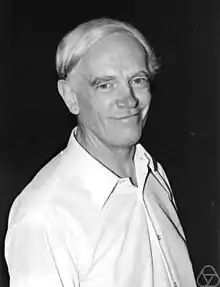Ernst Witt
Ernst Witt (26 June 1911 – 3 July 1991) was a German mathematician, one of the leading algebraists of his time.
Ernst Witt | |
|---|---|
 Ernst Witt in Nice, 1970 | |
| Born | 26 June 1911 |
| Died | 3 July 1991 (aged 80) |
| Alma mater | University of Göttingen |
| Known for | Witt algebra, Witt group, Hasse–Witt matrix, Bourbaki–Witt theorem, Poincaré–Birkhoff–Witt theorem, Witt's theorem, Witt vector |
| Scientific career | |
| Fields | Mathematics |
| Institutions | University of Hamburg |
| Doctoral advisor | Emmy Noether |
| Doctoral students | |
Biography
Witt was born on the island of Alsen, then a part of the German Empire. Shortly after his birth, his parents moved the family to China, and he did not return to Europe until he was nine.
After his schooling, Witt went to the University of Freiburg and the University of Göttingen. He joined the NSDAP (Nazi Party) and was an active party member.[1] Witt completed his Ph.D. at the University of Göttingen in 1934 with Emmy Noether and later became a lecturer. He was then a member of a team led by Helmut Hasse. During World War II he joined a group of five mathematicians, recruited by Wilhelm Fenner, and which included Georg Aumann, Alexander Aigner, Oswald Teichmüller, Johann Friedrich Schultze and their leader professor Wolfgang Franz, to form the backbone of the new mathematical research department in the late 1930s, which would eventually be called: Section IVc of Cipher Department of the High Command of the Wehrmacht (abbr. OKW/Chi).[2][3]
From 1937 until 1979, he taught at the University of Hamburg. He died in Hamburg in 1991, shortly after his 80th birthday.
Work
Witt's work has been highly influential. His invention of the Witt vectors clarifies and generalizes the structure of the p-adic numbers. It has become fundamental to p-adic Hodge theory.
Witt was the founder of the theory of quadratic forms over an arbitrary field. He proved several of the key results, including the Witt cancellation theorem. He defined the Witt ring of all quadratic forms over a field, now a central object in the theory.
The Poincaré–Birkhoff–Witt theorem is basic to the study of Lie algebras. In algebraic geometry, the Hasse–Witt matrix of an algebraic curve over a finite field determines the cyclic étale coverings of degree p of a curve in characteristic p.
In the 1970s, Witt claimed that in 1940 he had discovered what would eventually be named the "Leech lattice" many years before John Leech discovered it in 1965, but Witt did not publish his discovery and the details of exactly what he did are unclear; see his collected works (Witt 1998, pp. 328–329).
Notes
- According to Schappacher (letter in Mathematical Intelligencer 1996) it was most certainly him and not Oswald Teichmüller, who attended Emmy Noether's private seminar held in her house while wearing his SA-uniform.
- "Army Security Agency: DF-187 The Career of Wilhelm Fenner with Special Regard to his activity in the field of Cryptography and Cryptanalysis (PDF)". Google Drive. 1 December 1949. p. 7. Retrieved 30 March 2016.
- TICOM reports DF-187 A-G and DF-176, ‘European Axis Signal Intelligence in World War II’ vol 2
References
- Kersten, Ina (1993), "Ernst Witt 1911-1991" (PDF), Jahresbericht der Deutschen Mathematiker-Vereinigung, 95: 166–180
- Schappacher, Norbert; Scholz, Erhard (1996). "How to Write about Teichmüller". Mathematical Intelligencer. 18 (1): 5–6.
- Witt, Ernst (1998), Kersten, Ina (ed.), Collected papers. Gesammelte Abhandlungen, Berlin, New York: Springer-Verlag, ISBN 978-3-540-57061-5, MR 1643949
